
Get up to 4 quotes by filling in only 1 quick form

Compare quotes and find yourself the best deal

Increase the value of your home by installing new windows
- Householdquotes.co.uk
- Windows
House Windows In The UK: Complete Guide (2024)


- Popular types of home window options include casement, sash, tilt and turn, and French, among others.
- The most popular types of window materials include uPVC, aluminium, and timber.
- Double, triple, and secondary glazing are the most common types of glazing.
Finding new windows can require a lot of research, which is why we’ve created this resource for homeowners in the UK. Generally, windows are made of uPVC, aluminium, or timber, and come in a variety of styles. A standard window replacement cost can be anywhere between £150 to £1,860 per window since prices can vary depending on glazing, window design, and size.
If you’re looking for windows in the UK, you will need an installer you can trust. Finding one can take days of research and you may still not be sure you’re getting the best prices. That’s why our service can provide you with quotes from up to 4 reliable installers we’ve thoroughly vetted ourselves.
With multiple quotes, you can be sure you’re getting a good idea of the prices in your area. All you need to do is fill out a 30-second form and we’ll handle the rest. Click the button below to get started.
- Quotes from local installers
- Payment by finance available
- Save up to £150 per year
It only takes 30 seconds

The different types of windows for home
Windows come in different shapes and sizes, with their own unique advantages and disadvantages. Each design varies in aesthetics, ventilation capabilities, and level of lighting it provides.
Here are some of the most popular UK windows styles:
1. Sash windows

A classic design that brings an old-school feeling to the homes that install it. With two movable windows, known as sashes, that slide vertically or horizontally within the frame. Sash windows are also great for conserving space since they open vertically as opposed to inward or outward unless they are sliding sash windows.
Airflow can be easily regulated by raising or lowering the sashes, letting in air. They are a classical design that can enhance lighting and are a great choice for a wide variety of homes.
2. Tilt and turn windows

Tilt and turn windows are the most versatile type of window, providing the best of both worlds. The level of ventilation they provide is easy to adjust according to your exact needs. They often come with variable window handle positions that decide the orientation of how and where the window opens from.
They often sport a modern look compared to many other designs and are very easy to clean since they open in a variety of ways which provides multiple angles for cleaning.
3. French windows

Originally a Roman design that became popularised in France (thus the name), French windows provide wide ventilation and light entry points. With an outward opening and usually two windows, they have a classic look offering a wide, dual opening ideal for framing a landscape.
The design utilises panes that can open outward or inward, depending on how it’s built. These can be a great addition to vacation homes or scenic locations with a view. They often have a grid pattern or glazing bars on the pane but these can vary from design to design.
4. Casement windows

The most common and cheapest style of windows available in the UK. The casement window is a simple but effective design that allows for a good amount of ventilation from the outside. The simplicity of their basic design often means that they can work with any type of home.
They are also very versatile as a design: casement windows can have different frames, swing outward or inward, have a double window design, and quite a bit more.
No matter what window design you choose, you will need an installer who can get you the best deals. Finding a reliable one often takes days of strenuous research which not everyone has time for. That’s where our service comes in, offering you up to 4 free, non-binding quotes quickly and easily.
All you need to do is fill out a quick, 30-second form and we’ll handle the rest. We have a vast network of reliable installers who are up to the task. Click the button below to get started.
- Quotes from local installers
- Payment by finance available
- Save up to £150 per year
It only takes 30 seconds

5. Bay windows

A bay window will generally consist of three or more panes projecting outward. The most popular design utilises a central window flanked by two angled windows on either side which enhances interior space by creating additional seating or display areas. This setup can be great for bringing in sunlight from a range of directions and a large diameter.
The expansive views and increased natural light make them a classy design often used in living and dining rooms, even if they are expensive. Numerous styles of bay windows include curved, box, or angled configurations. They add aesthetic appeal to both the interior and exterior of a building with a broad design that illuminates the whole room.
6. Bow windows
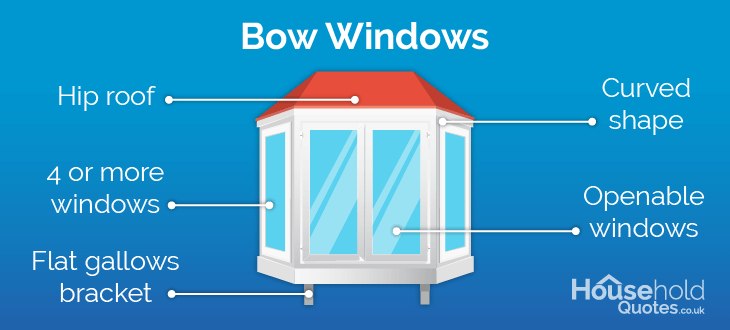
Often considered a sister design to the bay window, bow designs are composed of four or more windows arranged in a curved or semicircular configuration. Its many panes often form a gentle curve outward from the building’s facade. Much like the bow window, it can open up a room and let in light through a panoramic view.
Bay windows also provide additional interior space for seating and decoration. They often adds a visual flair to a home and enhances the value of a property. These can be a feature of living rooms in particular. They are an excellent way to provide a view of any lush outdoor scenery.
7. Double hung windows
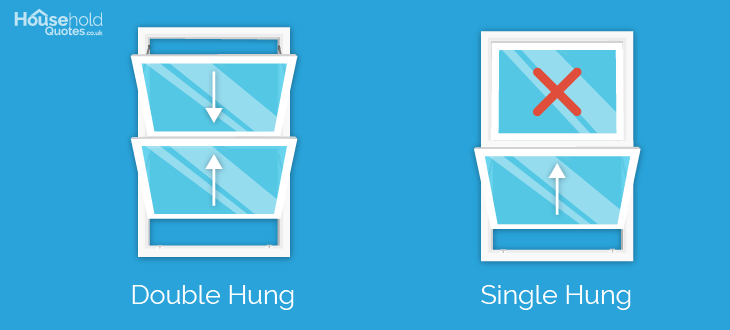
Double hung windows operate with two panes that can be lowered or raised in proportion to each other. This design can provide versatility in ventilation because these sashes open up on different levels that can help the user control airflow. It is also easy to clean especially in designs that tilt inward. The two windows allow great illumination and can accommodate various architectural styles and sizes.
8. Sliding windows

Sliding windows offer slidable panes arranged horizontally. These windows provide ample sunlight and can be of higher length. They are often similar to sliding doors both in design and size. Both doors and windows that slide offer thin frames as well, making aluminium a great choice as a material.
With a modern design that brings in a lot of ventilation when opened, sliding windows are a valuable addition to homes with a more contemporary aesthetic. The thin frames and minimal elements make sliding windows particularly great for letting in light and airflow.
The different types of window frames
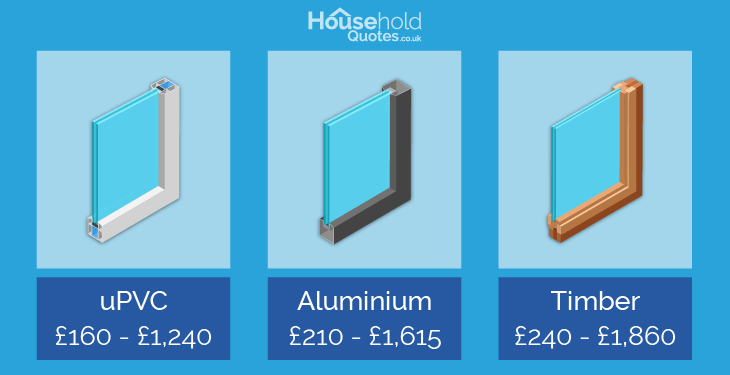
The material your window frame is made from is about a lot more than cost and visual appeal. Different materials vary in their rates of insulation, lifespans, and noise reduction, as well as how many times they can be recycled.
Here are the most common materials for UK windows:
1. uPVC window frames
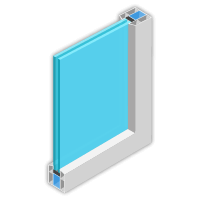
While uPVC is not the most expensive option, don’t let the price tag fool you. There are many advantages to this modest material. Despite being a plastic product, it is fairly recyclable. It is also low maintenance since it requires minimal cleaning while maintaining a consistent look.
That said, uPVC does have some drawbacks worth considering. The aesthetic qualities are often not as well-regarded as other materials. It is also not as solid as wood or aluminium and is comparatively less sustainable. It also is not as efficient at blocking heat or sound.
| Advantages | Disadvantages |
|---|---|
| Affordable | Not considered the best looking material |
| Decent energy efficiency | Can crack easier than wood or aluminium |
| Low maintenance (easy to clean) | Not as sustainable as wood or aluminium |
| 20-year lifespan on average | |
| Recyclable up to 10 times |
2. Aluminium window frames
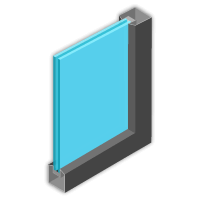
Aluminium is a great mid-price choice that can also be long-lasting if properly taken care of. With little maintenance required, aluminium windows with a thermal break can be highly energy efficient while also being lightweight. The lighter weight also allows for sleek, thin frames that can maximise the space taken by the window pane.
In terms of downsides, aluminium can be prone to corrosion from salt water, so it isn’t ideal for beachfront properties. It can also rack up condensation, collecting water droplets which could potentially lead to mould. Scratches may also be an issue as they are harder to cover up than on other materials. Consequently, while most windows are treated to prevent corrosion, aluminium will be more prone to it if scratched and/or damaged.
| Advantages | Disadvantages |
|---|---|
| More affordable than timber windows | Will corrode if damaged |
| High energy efficiency (with a thermal break) | More prone to condensation |
| Low maintenance | Scratches and dents require professional repair |
| 40-year lifespan on average | |
| 100% recyclable | |
| Lightweight with a modern aesthetic |
3. Wood window frames

Sporting the highest thermal efficiency out of all the standard window materials, wooden windows are a long-lasting material that brings a classical look to any property. Aside from the thermal efficiency and savings on energy, wood is also recyclable and renewable (especially softwoods which grow faster). They are also great for noise insulation, making them ideal for areas with a lot of sound pollution.
On the other hand, they can be expensive. Whether the purchase costs are worth the energy savings and lifespan can be up to the individual homeowner. They may also require polishing and repainting over time, along with maintenance checks to prevent moisture-based warping.
| Advantages | Disadvantages |
|---|---|
| High thermal efficiency | Expensive |
| High noise reduction | Requires regular maintenance |
| Potentially 60-year lifespan | Chance of termite infestation |
| Classic look | |
| 100% recyclable and renewable |
Regardless of the material you want, one factor that ensures long-lasting and energy-efficient windows is the installation. That’s why you need a reliable installer who is up to the task. Finding one can be a difficult task that takes up days of research, calling up companies, and comparing prices. Luckily, we offer a quicker, easier solution.
Our service can provide up to 4 free, non-binding quotes from reliable companies in your area. We’ve thoroughly vetted them so you don’t have to go through all the hassle yourself. Click the button below to get started.
- Quotes from local installers
- Payment by finance available
- Save up to £150 per year
It only takes 30 seconds

The different types of glazing
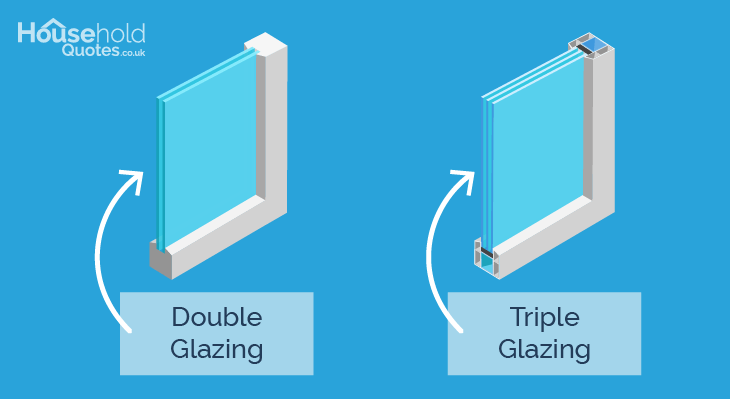
Much like various materials, the different types of glazing can result in levels of insulation and noise reduction. Glazing can be instrumental in improving thermal efficiency but that may not mean it is automatically the best choice for your home.
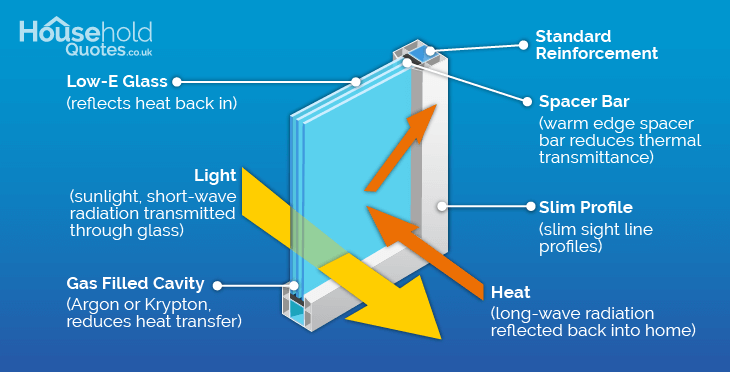
Let’s take a deeper look at the most common types of glazing:
Double Glazing
Double glazing is the most prevalent type of glazing in the UK. It provides a stable mix of thermal insulation and energy efficiency while also being affordable for most. It is pretty much standard in most of the UK but there are still many older homes that may have single glazing.
In the UK, double glazing can be even cheaper if you’re looking to replace and upgrade your single glazing. Several windows grants like ECO4, Warmer Homes Scotland, and Home Upgrade Grant include it as a possible measure for improving your home’s energy efficiency.
Secondary glazing
Secondary glazing involves adding another window pane into a window pane without removing the existing single glazing. Rather than having a double glazed window added, the installer will add a pane on top of the existing window.
Secondary glazing is less effective than most other types of glazing but it has its advantages. For one, it is cheaper and easier to install. In certain cases, such as houses in protected or historic zones, secondary is the only type of glazing you can install due to how easy to install and remove it is.
Triple glazing
Triple glazing takes double glazing to the next level, offering an extra layer of thermal efficiency and noise reduction. However, it may not automatically be the best choice for every home. Not every region is cold enough to benefit from the extra layer. It is also expensive, with the average triple glazing cost being 30% to 50% higher than that of standard double glazing cost, so it’s best to be sure your home will benefit from the thermal efficiency.
Even so, triple glazed windows provide better noise reduction and have better security features. They can also improve the EPC rating of your home, adding value to the property.
Single-pane glass
This version offers minimal glazing and the lowest energy efficiency. This can work in warmer regions but often means a lot of energy will be lost during winter months. As the name suggests, this type of window consists of a single layer of glass and is the basic and traditional option for windows.
Its core advantage is that it is less expensive compared to multi-pane alternatives. At the same time, it is prone to heat loss, condensation, and increased noise transmission. It commonly exists in older homes or buildings with simpler window designs. It isn’t widely available in the UK due to building regulations around energy efficiency.
Gas-filled glass
While not all glazing is gas-filled, it is often expected to be (double and triple glazing usually are). Gas-filled glass often contains xenon, argon, or krypton, all of which help maintain insulation. The gas acts as an insulator, allowing the window to be warmer in winter and colder in summer.
The density of the gases in the space between the glass is the main factor. Inert (noble) gases are used to fill the spaces between glass panes as they are non-reactive and heavier ones make for a decent insulation material.
If you’re looking to improve your window glazing, you will need the help of a reliable installer. A trustworthy installer can provide the best prices but finding one can be a difficult task that takes days of research. That’s why our service is the best way to streamline your search.
By filling out a simple 30-second form, you can obtain up to 4 free, non-binding quotes from the best installers in your region. With multiple quotes, you can adequately compare prices and pick the best one. Click the button below to get started.
- Quotes from local installers
- Payment by finance available
- Save up to £150 per year
It only takes 30 seconds

The different types of glass
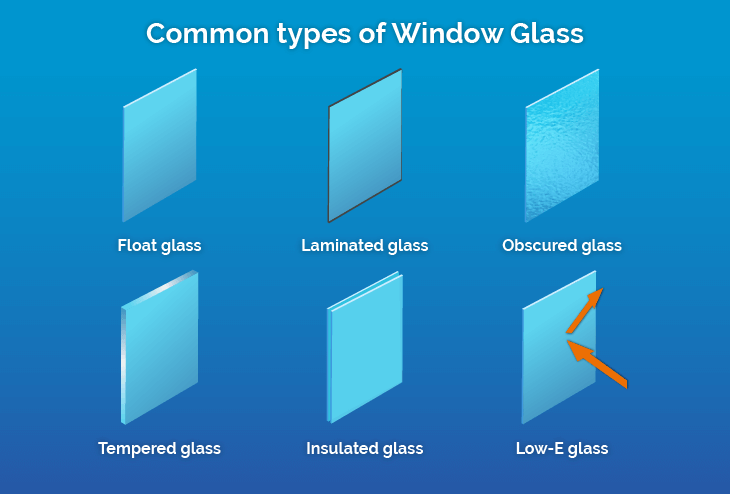
Selecting the appropriate type of glass for your needs is crucial for safety and energy efficiency. The various types can vary in aesthetic qualities, visibility, insulation, and purpose.
Float glass: This is a basic type of glass made from molten silicon, calcium oxide, and soda (among other materials), poured onto a tin surface to form large panels. It is usually used as a base for creating other types of glass due to its fragility. While it is a low-cost option, it is too fragile for heavy-duty processes.
Laminated glass: Laminated glass is built from two or more float glass layers with a PVB resin layer in between. The layering process provides strength and prevents shattering upon breakage, making it suitable for structures like car windshields and hurricane windows. Similarly, the UV protection it offers can help prevent damage to a home interior. Another advantage to the thickness of the material is that it enhances noise reduction.
Obscured glass: Often comes in etched or bevelled glass designs that decrease visibility while allowing some light penetration within a foggy texture. For this reason, it is often used in bathrooms that still need some light access. Also referred to as patterned glass, this type distorts the view on the other end.
Tempered glass: As the name suggests, this type of glass undergoes tempering and then annealing, which allows for a higher-strength material. Even when it breaks it forms into smaller, less dangerous pieces compared to regular glass upon impact. It also has exceptional clarity despite the thickness of its layers.
Insulated glass: Offers an improved U-factor and solar heat gain coefficient, both of which enhance its energy efficiency. Utilising multiple panes separated by a spacer bar and insulation with gases like argon or krypton, insulated glass is ideal for homes in colder regions. Enhanced energy efficiency can be achieved by adding additional panes much like in triple glazing.
Low-E glass: Designed to block UV rays while maintaining heat during winter. Low-E glass offers protection against UV damage to skin and materials like furniture and clothing so it is a popular choice in sunnier regions. It features multiple panes separated by a spacer bar, preventing heat transfer between the layers. Additional panes improve its efficiency and blocking while tight seals around the glass can help maintain insulation efficiency. However, seal failure may lead to condensation between panes, obstructing the view. To address this issue, insulated glasses can be enhanced with gas-filled and Low-E coatings.
The best window deals for your household
Windows can be quite an investment, which is why you’ll need to be sure you’re getting the best prices. To do that, you will need the assistance of a reliable installer. Finding one is not easy as it requires days of research, calling up companies, and comparing their offers. If that sounds like too much of a hassle, we can offer a far better alternative.
Our service provides you with up to 4 free, non-binding quotes from trustworthy installers in your area. With multiple prices, you can get a good idea of what you might be paying. Click the button below to get started if you’re looking for windows for a house in the UK.
- Quotes from local installers
- Payment by finance available
- Save up to £150 per year
It only takes 30 seconds

FAQ
Windows come in a variety of styles including casement, sash, tilt and turn, french, bay, bow, sliding, picture windows, and even more. They can also vary in terms of materials and types of glazing.
Yes. Aside from aesthetic upgrades, old windows can lose their ability to keep your home warm which may be costing you more in electricity bills. How much insulation they provide depends on the frame material.
Depending on the material, design, size, and type of glazing, windows will cost between £150 to £1,860. The cost varies by a wide margin because there is a broad range of window designs.
While it is possible to install windows yourself, bad installation could lead to wasted money and bad insulation within your home. This is why it’s better to call a professional installer.

Rawal Ahmed is a writer at Household Quotes with an interest in sustainability and a background in tech journalism and digital marketing.
